Dr. Nan Walker, Louisiana State University Earth Scan Lab (ESL)
“LSU Earth Scan Lab (ESL) Satellite Image Products for GCOOS”
This talk will overview the satellite imagery that GCOOS is  funding ESL to produce daily, as well as applications for this imagery. A GOES SST animation will be shown to highlight the detachment of Warm Core Eddy Zodiac from the Loop Current around Christmas 2022. The record-breaking flood of the Mississippi River in 2019 will be discussed using a MODIS true color image animation. In addition, a short tour of the ESL website will be provided to facilitate accessing animations of hurricanes and hurricane cool wakes as well as the long-term (2-20 years) image archives, that document coastal and deep-water conditions and events in the Gulf of Mexico.
funding ESL to produce daily, as well as applications for this imagery. A GOES SST animation will be shown to highlight the detachment of Warm Core Eddy Zodiac from the Loop Current around Christmas 2022. The record-breaking flood of the Mississippi River in 2019 will be discussed using a MODIS true color image animation. In addition, a short tour of the ESL website will be provided to facilitate accessing animations of hurricanes and hurricane cool wakes as well as the long-term (2-20 years) image archives, that document coastal and deep-water conditions and events in the Gulf of Mexico.
Dr. Nan Walker has more than 30 years of experience in satellite remote sensing of coastal and oceanic processes. She has been employed as a faculty member at LSU in the Coastal Studies Institute and the Department of Oceanography and Coastal Sciences for more than 30 years, where she teaches graduate and undergraduate courses, advises M.S. and Ph.D. graduate students in their research, and has directed the ESL since 2003. She specializes in using satellite data to advance the understanding of physical processes and air-sea interactions, and has conducted research in the Gulf of Mexico, Florida Keys/Bahama Bank region, the southern African region and the Caribbean Sea. Her research interests include Loop Current eddy circulation, air-sea interactions related to hurricanes and winter storms, estuarine-shelf exchange processes, surface sediment transport, coastal upwelling, and ocean climatology. She has experience in the application of visible, thermal, and microwave (SAR) satellite measurements. In recent years, she has focused on understanding Loop Current frontal eddy cyclone impacts on circulation and on ocean-atmosphere interactions that impact hurricane intensity changes. She has a B.S. in Marine Zoology (Duke University), an M.S. in Marine Sciences (Louisiana State University), and a Ph.D. in Physical Oceanography (University of Cape Town, South Africa). She spent a 2-year “sabbatical” with her husband starting in 1989 (after her Ph.D.), sailing their 32-foot sailboat from Cape Town to the Gulf of Mexico, with a 6-month research experience in the West Indies Marine Lab, U.S. Virgin Islands, studying Hurricane Hugo’s impacts on the corals of St Croix. Her hobbies include scuba diving, photography, hiking, bicycling, and gardening.






 ecology, biodiversity conservation, environmental engineering, geospatial data science, ecological economics, ecological restoration, fisheries sustainability, and climate change risk management.
ecology, biodiversity conservation, environmental engineering, geospatial data science, ecological economics, ecological restoration, fisheries sustainability, and climate change risk management.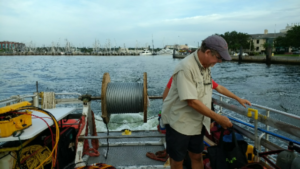 and the maritime transportation community. AI routines are being developed to improve the forecast of met/ocean parameters at critical navigation points near the busiest Gulf ports by integrating available observations and model hindcasts/nowcasts/forecasts with vessel tracking data to predict optimal vessel arrival times to satisfy published Vessel Handling Guidelines for tide, current, and wind conditions.
and the maritime transportation community. AI routines are being developed to improve the forecast of met/ocean parameters at critical navigation points near the busiest Gulf ports by integrating available observations and model hindcasts/nowcasts/forecasts with vessel tracking data to predict optimal vessel arrival times to satisfy published Vessel Handling Guidelines for tide, current, and wind conditions. that precipitated the collection of ADCP data. The introductory notes will also cover the transition period from the National Data Buoy Center to GCOOS on the collection and curation of the ADCP data. The current status of the effort and a short presentation of the BSEE/NTL data portal will follow. The talk will culminate with plans to enhance the data services.
that precipitated the collection of ADCP data. The introductory notes will also cover the transition period from the National Data Buoy Center to GCOOS on the collection and curation of the ADCP data. The current status of the effort and a short presentation of the BSEE/NTL data portal will follow. The talk will culminate with plans to enhance the data services.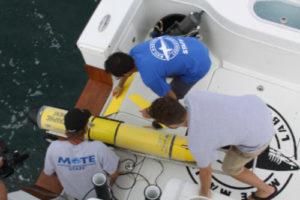 in 2022 as Senior Engineer/Manager of the Ocean Technology Program, which develops and utilizes various forms of cutting-edge technology in conjunction with a wide range of interdisciplinary scientific goals to solve problems, streamline processes, and monitor water quality in the eastern Gulf of Mexico. He joined Mote from Florida Gulf Coast University, where he most recently served as an adjunct professor in the Environmental Engineering Department. He received his B.S. in Applied Science and Technology from Thomas A. Edison State College in 2011 and his M.S. in Unmanned Systems from Embry-Riddle Aeronautical University in 2016.
in 2022 as Senior Engineer/Manager of the Ocean Technology Program, which develops and utilizes various forms of cutting-edge technology in conjunction with a wide range of interdisciplinary scientific goals to solve problems, streamline processes, and monitor water quality in the eastern Gulf of Mexico. He joined Mote from Florida Gulf Coast University, where he most recently served as an adjunct professor in the Environmental Engineering Department. He received his B.S. in Applied Science and Technology from Thomas A. Edison State College in 2011 and his M.S. in Unmanned Systems from Embry-Riddle Aeronautical University in 2016. of Southern Mississippi’s Central Gulf of Mexico Ocean Observing System and the ocean science and monitoring efforts it is conducting as part of GCOOS with buoys, uncrewed maritime systems and high frequency radars.
of Southern Mississippi’s Central Gulf of Mexico Ocean Observing System and the ocean science and monitoring efforts it is conducting as part of GCOOS with buoys, uncrewed maritime systems and high frequency radars. of Oceanography and the holder of the James Whatley Endowed Chair for Geosciences. Prior to coming to Texas, he was responsible for developing the Bermuda Institute for Biological Sciences (BIOS) from a small biological station into a world-renowned center on oceanographic research.
of Oceanography and the holder of the James Whatley Endowed Chair for Geosciences. Prior to coming to Texas, he was responsible for developing the Bermuda Institute for Biological Sciences (BIOS) from a small biological station into a world-renowned center on oceanographic research.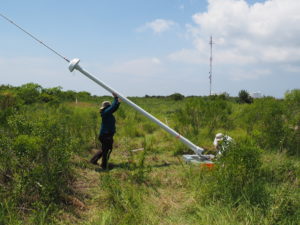
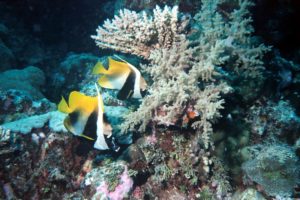 work is part of the Healthy Ecosystems and Living Resources Key Focus Area of the GCOOS Strategic Plan (2020-2025).
work is part of the Healthy Ecosystems and Living Resources Key Focus Area of the GCOOS Strategic Plan (2020-2025). funding ESL to produce daily, as well as applications for this imagery. A GOES SST animation will be shown to highlight the detachment of Warm Core Eddy Zodiac from the Loop Current around Christmas 2022. The record-breaking flood of the Mississippi River in 2019 will be discussed using a MODIS true color image animation. In addition, a short tour of the ESL website will be provided to facilitate accessing animations of hurricanes and hurricane cool wakes as well as the long-term (2-20 years) image archives, that document coastal and deep-water conditions and events in the Gulf of Mexico.
funding ESL to produce daily, as well as applications for this imagery. A GOES SST animation will be shown to highlight the detachment of Warm Core Eddy Zodiac from the Loop Current around Christmas 2022. The record-breaking flood of the Mississippi River in 2019 will be discussed using a MODIS true color image animation. In addition, a short tour of the ESL website will be provided to facilitate accessing animations of hurricanes and hurricane cool wakes as well as the long-term (2-20 years) image archives, that document coastal and deep-water conditions and events in the Gulf of Mexico.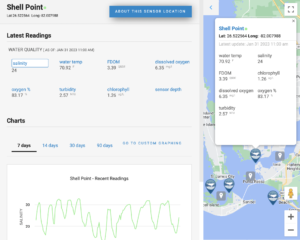 have persistent harmful algal blooms from freshwater (cyanobacteria) to marine (dinoflagellate) environments. The establishment of nine real-time sensor platforms throughout estuary and surrounding barrier islands in 2007 has broadened the understanding of the sources of freshwater, either Lake or watershed, on water quality. The data are used for research purposes and are summarized into weekly condition reports that are shared with academic, state and federal partners.
have persistent harmful algal blooms from freshwater (cyanobacteria) to marine (dinoflagellate) environments. The establishment of nine real-time sensor platforms throughout estuary and surrounding barrier islands in 2007 has broadened the understanding of the sources of freshwater, either Lake or watershed, on water quality. The data are used for research purposes and are summarized into weekly condition reports that are shared with academic, state and federal partners.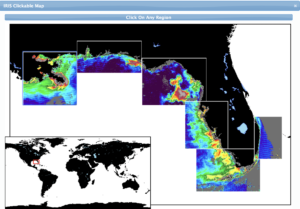 developed:
developed: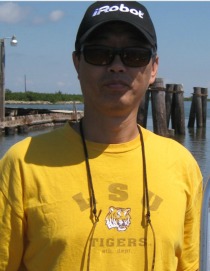 Dr. Li will review the status of Wave-Current-Surge Information System (WAVCIS), the observational and research activities pertinent to GCOOS-funded work, and the future prospects.
Dr. Li will review the status of Wave-Current-Surge Information System (WAVCIS), the observational and research activities pertinent to GCOOS-funded work, and the future prospects.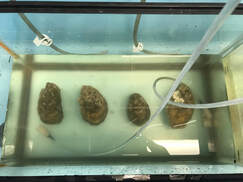 been under way to identify new, accurate and affordable technologies in the nutrient sensor market, test those technologies against stated specifications and ultimately, assess integration of those technologies in existing monitoring programs. With support from EPA and NOAA through the Alliance for Coastal Technologies and GCOOS, a partnership of monitoring groups has been testing deployment of an affordable (<$10k) wet chemical nitrate sensor in Gulf of Mexico estuaries. Lessons learned from this work, along with ongoing efforts to build a nutrient sensor monitoring network in the Gulf, will be presented and discussed.
been under way to identify new, accurate and affordable technologies in the nutrient sensor market, test those technologies against stated specifications and ultimately, assess integration of those technologies in existing monitoring programs. With support from EPA and NOAA through the Alliance for Coastal Technologies and GCOOS, a partnership of monitoring groups has been testing deployment of an affordable (<$10k) wet chemical nitrate sensor in Gulf of Mexico estuaries. Lessons learned from this work, along with ongoing efforts to build a nutrient sensor monitoring network in the Gulf, will be presented and discussed. products for the Gulf of Mexico to the GCOOS Data Management and Communications (DMAC) subsystem. He will also provide an update of the altimeter data products and review recent significant oceanographic events in the Gulf.
products for the Gulf of Mexico to the GCOOS Data Management and Communications (DMAC) subsystem. He will also provide an update of the altimeter data products and review recent significant oceanographic events in the Gulf.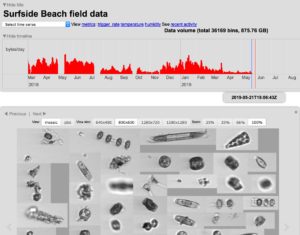 automated operation and data processing, together with machine-learning technology, enables near real-time reporting of individual phytoplankton species abundance and community composition. Sustained operation of this novel technology at the Texas Observatory for Algal Succession Time series (TOAST) in Port Aransas, Texas, since 2007, and Surfside Beach, Texas, since 2017, has provided successful early warning for HAB events. Initial stages of HABs are detected with sufficient time to close shellfish harvesting and prevent human illness. In addition, time series data have been used in particle tracking and individual based models to identify the origins of HABs sources and the importance of physical factors in bloom initiation. Examination of archived images from this high temporal resolution (hourly to daily) time series at TOAST has furnished new insights on interactions among the plankton (e.g., parasites, symbionts, grazers) and the dynamics of phytoplankton community structure.
automated operation and data processing, together with machine-learning technology, enables near real-time reporting of individual phytoplankton species abundance and community composition. Sustained operation of this novel technology at the Texas Observatory for Algal Succession Time series (TOAST) in Port Aransas, Texas, since 2007, and Surfside Beach, Texas, since 2017, has provided successful early warning for HAB events. Initial stages of HABs are detected with sufficient time to close shellfish harvesting and prevent human illness. In addition, time series data have been used in particle tracking and individual based models to identify the origins of HABs sources and the importance of physical factors in bloom initiation. Examination of archived images from this high temporal resolution (hourly to daily) time series at TOAST has furnished new insights on interactions among the plankton (e.g., parasites, symbionts, grazers) and the dynamics of phytoplankton community structure.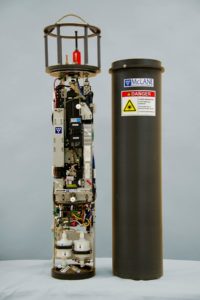 algal bloom species such as Karenia brevis within the Northern Gulf of Mexico. Specifically, these efforts involve deploying an Imaging FlowCytobot within Mobile Bay which — along with currently deployed instruments within GoM — will feed into a new imaging analysis pipeline for real-time monitoring of key HAB species through the GCOOS portal.
algal bloom species such as Karenia brevis within the Northern Gulf of Mexico. Specifically, these efforts involve deploying an Imaging FlowCytobot within Mobile Bay which — along with currently deployed instruments within GoM — will feed into a new imaging analysis pipeline for real-time monitoring of key HAB species through the GCOOS portal.







